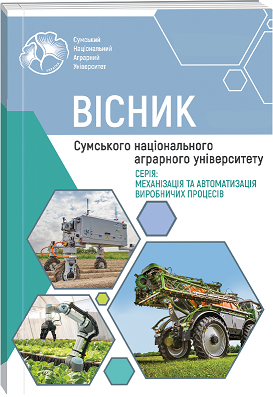OPTIMIZATION OF THE MOVEMENT MODE OF A MANIPULATOR WITH TWO PROGRESSIVE AND ONE ROTARY LINKS IN THE PLANE OF CHANGE OF RANGE
Abstract
The cited scientific work presents the process of optimizing the motion modes of a manipulator robot with two translational and one rotational links in the plane of change of departure of the gripping device with the load. This process includes the selection of a movement path of the gripper between two points of movement of the load, in which the minimum distance of movement of the gripper is ensured. The movement mode of the gripping device with the load along the selected trajectory is optimized according to a certain criterion. The gripper movement mode was optimized according to two integral dynamic criteria, which reflect the average values of kinetic energy and dynamic power component in the movement section. According to the first criterion, the mode of movement of the gripping device with a constant speed over the entire movement section is optimal, and according to the second criterion, the optimal speed should change according to the parabolic law. In the optimal energy mode of movement of the gripping device with a load, there are no start and stop sections, so it can be used only in the section of steady movement of the gripper. The optimal movement mode of the gripping device according to the criterion of the dynamic component of power ensures the minimum value of the power of the drive mechanisms, however, when using such a mode on the entire movement section, it leads to an increase in energy costs. This mode of movement of the gripping device is recommended for use in the start and stop areas, as well as when moving the gripper over small distances. A complex optimal mode of movement of the gripping device is also determined, where the speed changes according to the parabolic law in the starting and braking sections, which corresponds to the optimal dynamic mode of motion, and in the section of steady motion is constant and provides the optimal energetic mode of motion. The connections between the characteristics of the optimal motion modes of the gripping device with the load along the selected trajectory and the coordinate axes in the plane of departure change are established. Also, by solving the inverse problem, the kinematic characteristics of the generalized coordinates of the manipulator at the selected optimal modes of movement were determined in order to establish the necessary parameters and characteristics of the drive mechanisms for lifting and extending the gripper arm and their control systems. The connections between the characteristics of the optimal movement modes of the gripping device with the load along the selected trajectory and the coordinate axes in the plane of departure change are established. Also, by solving the inverse problem, the kinematic characteristics of the generalized coordinates of the manipulator at the selected optimal modes of movement were determined in order to establish the necessary parameters and characteristics of the drive mechanisms for lifting and extending the gripper arm and their control systems. The connections between the characteristics of the optimal movement modes of the gripping device with the load along the selected trajectory and the coordinate axes in the plane of departure change are established.
References
2. Faustini A., Oriolo G., Vendittelli M., Freda L. (2015). Adaptive control of robot manipulators with trajectory trackin. International Journal of Control, vol. 88. no. 11. pp. 2245-2257.
3. Gao X., Qian Y., Zhou Y. (2019). Optimal trajectory planning for robotic manipulators based on an improved artificial bee colony algorithm. Robotics and Computer-Integrated Manufacturing. vol. 55. pp. 79-89.
4. Gharavian M. Ahmadi M. T. (2012). A new approach to inverse kinematics solution for redundant manipulators using the ant colony algorithm. Mechatronics. vol 22. no 5. pр. 579-587.
5. Hameed Z. K., Atiq M. T. (2021). Solving inverse kinematics problems of redundant manipulators using a hybrid learning algorithm. Applied Soft Computing. vol 98. pр. 106885.
6. Jahanbekam M. R., Alasty A., Moosavi M. R. (2016). A comparison of gradient-based optimization algorithms for inverse kinematics of redundant manipulators. Robotica. vol 34. no 9. pр. 2023-2037.
7. Kim M. K., Lee K. R., Park H. W. (2018). Trajectory planning and control of a wheeled mobile robot for path following in outdoor environments. International Journal of Control, Automation, and Systems. vol. 16. no. 6. pp. 2707-2717.
8. Kim S., Lee S. S., Kim H. S. (2017). Optimal trajectory planning and control of a quadrotor using a nonlinear model predictive controller. Journal of Intelligent and Robotic Systems. vol. 87. no. 1. pp. 105-117.
9. Li H., Chen W., Lu W. (2017). Trajectory tracking control of a four-wheel-steering electric vehicle based on differential flatness. International Journal of Advanced Robotic Systems. vol. 14. no. 1. pp. 1-12.
10. Loveikin V., Romasevych Y., Loveikin A., Lyashko A., Korobko M. (2022). Minimization of high frequency oscillations of trolley movement mechanism during steady tower crane slewing. U.P.B Sci. Bull. Series D. 84. N 1. P. 31-44.
11. Loveikin V., Romasevych Y., Shymko L., Mushtin D., Loveikin Y. (2021). The optimization of luffing and slewing regimes of a tower crane. Journal of Theoretical and applied Mechanics. 51. P. 421-436.
12. Lovejkin V. S., Mishchuk D. A. (2019). Synthesis of the optimal dynamic mode of movement of the manipulator boom mounted on an elastic base. Science and technology. Vol.18. Nr.1. 55-61.
13. Loveykin V. S., Mishchuk D. O., Mishchuk Ye. O. (2022). Optimization of manipulator's motion mode on elastic base according to the criteria of the minimum central square value of drive torque. Strength of Materials and Theory of Structures. Nr.109. рр. 403-415.
14. Mousavi M. R., Gholami M. (2018). A review of inverse kinematics solutions for serial-link robot manipulators. Journal of Intelligent and Robotic Systems. vol 90. no 1-2. pр. 17-49.
15. Saha S. K. Bhattacharyya B. (2018). Trajectory optimization of robot manipulators: A review. Robotics and Autonomous Systems. vol. 101. pp. 52-71.
16. Wang Y., Gao Z., Zhu J. (2017). Multi-objective optimization of robot path planning based on improved genetic algorithm. Journal of Intelligent & Robotic Systems. vol. 88. no. 1. pp. 29-44.
17. Zeeshan A. I., Atiq M. T., Ehsan M. (2014). Inverse kinematics solutions using neural networks for a five degree of freedom robot manipulator. International Journal of Advanced Robotic Systems. vol 11. no 10. pр. 1-8.
18. Zhang J., Li J., Liu Y. (2018). Optimal trajectory planning for industrial robots based on simulated annealing algorithm. Journal of Intelligent & Robotic Systems. vol. 89. no. 3-4. pp. 577-592.
19. Zhang X., Hu W. (2019). Trajectory planning for autonomous underwater vehicles using a hybrid optimization algorithm. Journal of Intelligent and Robotic Systems. vol. 96. no. 1. pp. 69-84.

 ISSN
ISSN  ISSN
ISSN 



